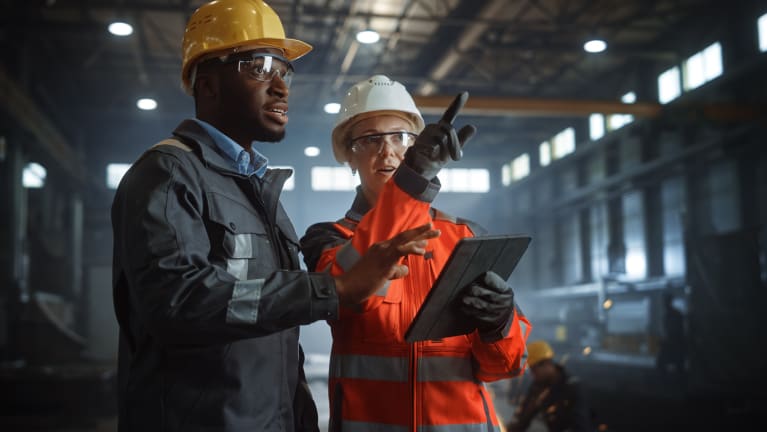

?A company that employed grounds workers in the U.K. instructed the employees to wear ear protection as they went about their work using lawn mowers and other loud machinery. However, several employees still ended up filing claims for reported hearing loss related to their noise exposure at work. The company had done the proper risk assessments and provided protective equipment. But the company was still found liable.
“They were liable there because they weren’t enforcing the use of them,” said Kate Donachie, an attorney with Brodies in Edinburgh, Scotland. “Employers have to do everything they can to make sure that employees are kept safe, and that means even challenging employees who wouldn’t keep themselves safe.”
Know Your Machinery
Managing the risks of employees who use machinery in the U.K. requires, first, an awareness of the kind of machinery in use.
“All machinery is not the same, so a piece of machinery that would achieve the same thing might have different risks attached depending on how old it is,” Donachie said. “The key thing is to understand what your employees are doing and what risks [they] are exposed to as a result of that.”
For example, information is usually available to employers about any machinery that can cause damage through noise or vibration.
“You should have manufacturer’s information available for that in terms of how much vibration it transfers per minute … and then it’s back to understanding what you’re asking your employees to do. How long do they spend using the equipment? How do they use the equipment?” Donachie said. “Employers might not be aware that their employees, for example, are using a piece of machinery for as long as two hours a day. … What does that look like across the course of a week or a month? So, it’s gathering the information.”
Conduct a Risk Assessment
Doing a detailed risk assessment should be a second step for employers who have employees using potentially dangerous equipment.
“For any automated equipment, risk assessment is absolutely vital,” said Ross Whalley, an attorney with Leigh Day in Manchester, U.K. “From the risk assessment, you have to consider who might be harmed, what level of harm may be caused, evaluate what those risks may be, record those findings and put in place control mechanisms to reduce the risk of that harm occurring. The greater the harm and risk, the more onerous the control mechanisms ought to be.”
It’s also important to train workers and communicate company policies clearly.
“Employers should set out a policy for how they approach health and safety in their business, which must be shared with employees,” Whalley said. “The employees that are going to be charged with using the machinery and those charged with repairing or maintaining it need adequate training, and the responsibility’s on the employer to train or provide suitable safety information and ensure those employees are appropriately trained to deal and come into contact with machinery.”
Track Potential Damage
After the risk assessment is in place, it’s also necessary to make sure that employees are following through with policies.
“You have to make sure they understand why and what they’re being asked to do, but beyond that, you have to have supervision and discipline,” Donachie said.
Sometimes, monitoring devices can be put in place to track vibration or sound exposure. Also, health monitoring can be a key component of risk assessment and risk tracking. So, for machinery that can cause hearing damage, it can be important to check the hearing of an employee before they begin work and at regular intervals throughout their employment.
“You would have that monitored on a regular basis so that you could pick up on any deterioration,” Donachie said. “Health surveillance is a key strand to the main strategy to protect employees.”
Consequences for Noncompliance
Consequences for employers who fail to keep employees safe when using machinery can range in severity.
“If it’s sufficiently severe, [companies] might find themselves prosecuted, and that could be a very significant fine,” Donachie said. “If it’s not severe enough to warrant a criminal prosecution, HSE [the U.K.’s Health and Safety Executive] can place a notice on the business saying you cannot do this kind of work until you sort it out.”
In some cases, punishment could include imprisonment or a suspended sentence.
Companies can also be sued by injured parties. “It used to be that if you breached health and safety legislation, there was an automatic right to damages and civil claims. Now, that’s been decoupled,” Donachie said.
In 2013, the U.K. government implemented the Enterprise and Regulatory Reform Act 2013, which diluted the applicability of health and safety legislation to employers.
“It sought to reduce the perceived burden of red tape on employers and businesses by turning previous health and safety legislation into guidance only,” Whalley said. “I think it was a huge setback for health and safety laws in England and Wales. The cases for injured parties against employers are now much more challenging to prove in the civil courts.”
Ultimately, it is the employer’s responsibility to put in place policies and monitoring that keeps employees using machinery safe.
“There has to be a positive culture toward keeping people safe,” Donachie said. “I think culture has to come from the top, that being a really serious buy-in at the top of the organization.”
Katie Nadworny is a freelance writer in Istanbul.

